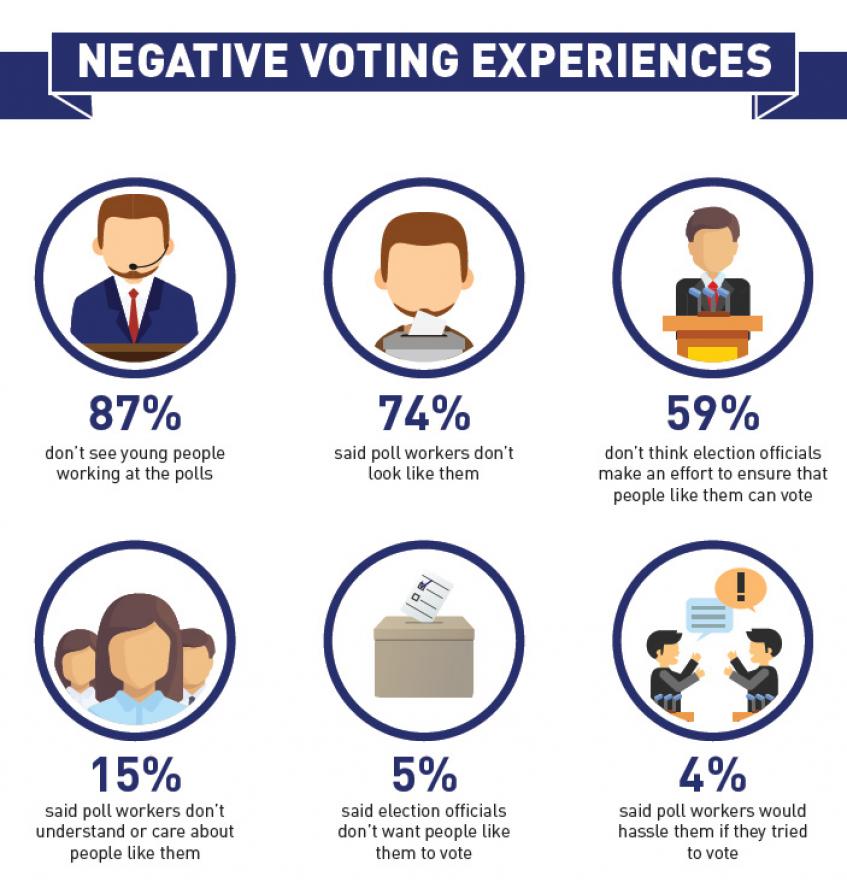Engaging a Broader Youth Electorate: 10 Recommendations for Increasing Voter Engagement
Today, CIRCLE is releasing the final report on a joint project conducted with Opportunity Youth United (OYU) which aims to engage low-income young people and local election administrators to make electoral systems to be more responsive to these marginalized voters’ needs. The report, based on a survey of over 1,200 young people from six politically and geographically diverse states, puts forth 10 recommendations for election administrators and youth allies that are interested in increasing electoral engagement.
Some of the key findings include:
- Young people, especially those from low-income backgrounds, face logistical barriers to voting, each of which may seem small, but together can make voting difficult. These barriers include having to find out where their polling place is located, not having transportation to the polling place, and having to work around their job schedule—an obstacle compounded by the fact that many have more than one job.
- Some of the youngest (and especially first-time) voters may not realize all of the requirements they need to meet in order to vote until they are actually trying to do it, by which time it may be too late. For instance, a quarter of our participants had moved within the last 12 months, but of those, only 40% had changed their voter registration address. At the same time, laws and tools designed to facilitate voter participation, such as online registration and text reminders for voting, are not widely used by low-income youth.
- Young people whose families face economic or other challenges may be getting the message that their right to participate in civic life is tenuous. Many of our participants assumed (mostly incorrectly) that a variety of minor criminal offenses and past convictions would bar them from voting. For instance, when asked if someone who has a suspended driver’s license would be able to vote, 24% wrongly believed they could not, and another 42% did not know.
- Some young people are apprehensive about going to the polling place because they rarely see people there that they can identify with 74% said they don’t see poll workers that “look like them,” and 87% said they do not see young people working at the polls. Relatively few actually experienced harassment at the polls, but 59% do not believe that election officials make an effort to ensure that people like them can vote.
- Finally we found that a significant minority of our participants (17%) felt that they do not “know enough” to vote. Well over half rely on family to get information about the election. However, participants with less formal educational experience reported relying less on family for news and information. Getting information from social media was common, with Facebook being the most common platform (60%), followed by Instagram (19%), Twitter (16%), Youtube (15%) and Snapchat (14%). Just over a quarter (28%) of youth say they have ever received paper voting guide from their local government.
Based on these findings, and taking a cue from the exemplary work of election administrators in many jurisdictions, we have developed 10 recommendations for facilitating diverse young voters’ participation in electoral process. We hope that these recommendations can serve as a jumping-off point for conversations between young people and local stakeholders, especially those who are involved in administration of elections. There is no one solution to combat low voter participation and disparities in the levels of participation among youth. That said, we strongly believe that youth voter-centric design of election systems can improve voter engagement in meaningful ways. Among those recommendations:
- Expand Access to Essential Information – Young people should be aware of all the ways they can register to vote, especially where online registration is available. This information should be highly visible and easily accessible, especially on mobile devices, not buried in PDFs or other documents that youth must download or print.
- Get Them Back on The Rolls – Many youth are unaware that, in some cases, they do not lose their right to vote for any period of time after a misdemeanor or felony arrest and/or conviction. Where that’s not the case, youth need access to state-specific information on voting rights restoration after a felony or misdemeanor arrest or conviction.
- Make Yourself Available to Young People – Youth who are new to the voting process may have questions, run into technical problems while trying to register online, or otherwise require support. Have processes and avenues to communicate with young people and answer inquiries, especially on platforms that youth typically use to communicate (i.e. text messages, messaging apps, and social media).
More recommendations are included in the full report.



